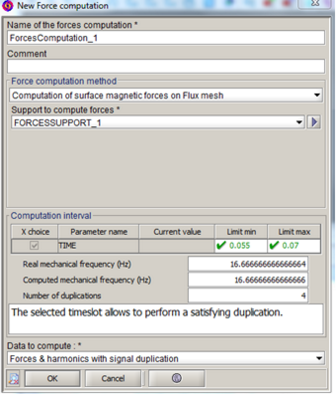Step 2 : Computation and export of the forces
Introduction
In this part, the method of creating the computation of surface magnetic forces on Flux mesh is described.
It is available through the menu or through the icon ![]()
Creation of force computation
The steps of the computation creation are described below. Images of the creation box of the computation are also available.
| Step | Action |
|---|---|
| 1 | Choose the name of the computation (+comment) |
| 2 | Choose the computation method Computation of surface magnetic forces on Flux mesh |
| 3 | Choose the computation support created beforehand |
| 4 |
In magnetic transient: Choose the computation interval according to the choice of applying or not a temporal duplication in the field Data to compute (See Spatial and temporal definition ). Reminders :
In steady state AC: Choose the forces to compute:
|
| 5 |
In magnetic transient: Choose the data to compute. It is about choosing :
It is strongly advisable to calculate the harmonics (if it has a physical meaning), as the computation of the harmonics is rapid. |
| 6 |
In magnetic transient: In case of temporal duplication, verify if the time interval is in good correlation with :
See Tools of geometric reconstruction and temporal duplication . |
| 7 | Validate by OK |
| 8 | Visualize the arrows of the forces or of the harmonics (See Postprocessing with forces arrows) |
Step 1 to 7:
